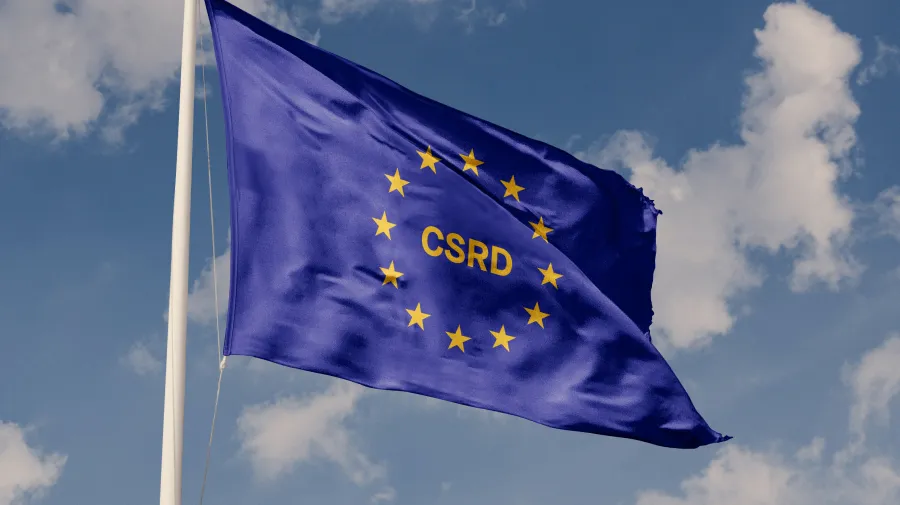Key dates for CSRD compliance
- 2014: NFRD is introduced for large public-interest entities.
- 2022: CSRD is adopted to replace and strengthen NFRD.
- 2024: First fiscal year of enforcement of the CSRD
- 2025: First publication of sustainability reports in compliance with the CSRD (“wave 1” companies)
Who will need to report in 2027?
According to the current CSRD rollout timeline, companies that cross the reporting thresholds for the first time in 2026 will need to publish their initial sustainability reports in 2027. This group includes:
- Large EU-based companies that exceed the proposed updated thresholds: more than 1,000 employees and €450 million in net turnover.
- Non-EU companies with annual net turnover of €450 million or more within the EU, if they operate a subsidiary or branch in the region.
- Companies listed on EU-regulated markets, regardless of where they are headquartered.
If your organization fits any of these criteria, it’s essential to begin preparations now—even though some technical details are still being finalized.
If your company is due to report in 2027, take a look at our dedicated resource.
What are companies required to report?
Companies must disclose information and provide essential information as part of their general disclosures. Sustainability information must be included in the reported information. Companies are required to disclose information about their business model, key initiatives, and various aspects of their operations.
- Environmental, social, and governance (ESG) policies and practices
- Risks and opportunities related to sustainability
- Impacts of business activities on the environment and society
- Progress toward sustainability targets
- Key initiatives and actions taken to address ESG issues
- Aspects such as employee well-being, community engagement, and environmental impact
Note: Disclosing information on these aspects is required under the CSRD.
Environmental
- Scope 1, 2, and 3 GHG emissions
- Climate-related risks and mitigation plans, including disclosure of transition plans and sustainability risks
- Resource usage (energy, water, waste), with a focus on resource use and its impact on the environment
Social
- Workforce diversity, pay equity, working conditions
- Human rights and value chain due diligence
- Community engagement, including the identification and management of impacts on consumers and other stakeholders such as investors and policymakers
Governance
- Board oversight of ESG issues
- Ethics and anti-corruption measures
- Sustainability risk management, providing transparency that is crucial for investors to assess governance practices and make informed investment decisions
Double materiality: a core principle
Companies must report based on double materiality, meaning they must disclose:
- Impact materiality: How the company affects people and the planet.
- Financial materiality: How ESG issues affect the company’s performance.
As part of this materiality assessment, companies are required to assess and report on ESG metrics and sustainability performance to ensure transparent and reliable disclosure of their sustainability impacts and progress.
This assessment determines which disclosures under the ESRS are relevant for each company.
What are the ESRS?
The European Sustainability Reporting Standards (ESRS) are developed by EFRAG to guide CSRD reporting and provide guidance for companies to comply with the CSRD. They include:
- Cross-cutting standards: General principles, strategy, governance
- Topical standards: ESG-specific topics like climate, biodiversity, labor
- Sector-specific standards (postponed): Tailored disclosures by industry
What about non-EU companies?
Non-EU companies will be required to comply with the CSRD from fiscal year 2028, with reports due in 2029. According to the proposed content directive, a non-EU company will fall under scope if it:
- Generates >€450M net turnover in the EU and
- Has either:
- an EU branch already subject to CSRD, or
- an EU subsidiary with >€50M net turnover
Separate ESRS for non-EU companies are expected, but not yet published.
Tip: If you’re a European branch of a non-EU group, your own CSRD compliance in 2026 or 2027 can help your parent company prepare for future requirements.
How to prepare for CSRD compliance
Preparation is key—especially for companies starting from scratch, as the CSRD requires companies to follow these steps for compliance. Here are 7 essential steps:
- Conduct a double materiality assessment Identify which ESG topics are material to your company and stakeholders. This filters applicable disclosures and informs all future reporting.
- Perform a gap analysis Compare your existing policies and disclosures against the ESRS. Pinpoint where data, governance, or controls fall short.
- Establish data governance Ensure sustainability data is traceable, auditable, and as robust as financial data. Align systems across business units.
- Engage internal and external stakeholders Collaborate across functions (finance, HR, procurement) and engage suppliers and partners early.
- Leverage ESG software Use technology to automate data collection, map disclosures, facilitate workflows, and ensure compliance with digital tagging requirements.
- Prepare for assurance Begin working with assurance providers early to develop validation processes, especially in decentralized organizations.
- Align with global frameworks CSRD integrates with GRI, SFDR, and ISSB (IFRS S1/S2), so aligning with these frameworks supports global consistency.
How ESG software supports CSRD readiness
With the CSRD’s detailed requirements and data demands, ESG software can help streamline your path to compliance. These tools reduce the manual burden and improve reporting accuracy by:
- Automating data collection from across departments and suppliers
- Mapping internal data to the ESRS disclosure requirements
- Facilitating double materiality assessments and stakeholder input
- Enabling digital tagging for structured reporting under the ESEF format
- Creating audit-ready outputs to support assurance and verification
By embedding the right technology early, companies can improve efficiency, reduce risk, and build a strong foundation for long-term, scalable sustainability reporting.
A strategic opportunity
While the CSRD may seem complex, it offers a clear roadmap for businesses to evolve their sustainability strategy. Companies that act early can turn regulatory compliance into a competitive edge, positioning themselves for long-term success in a climate-conscious economy.




